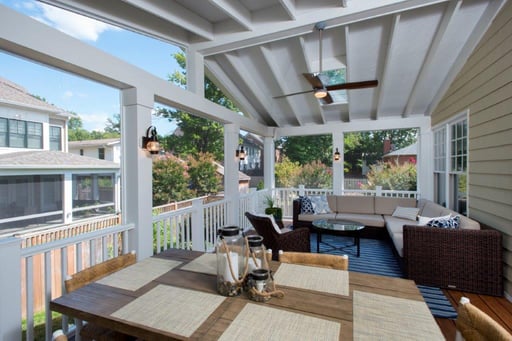If you live anywhere in the Mid-Atlantic, and your porch is more than 30 inches above the ground, you’re probably required to have railings on your screened porch. Local building codes mandate that all porches in Maryland and Virginia have this for safety reasons. The same is true for stairs with more than three risers.
Fortunately, there’s a lot of design flexibility when it comes to railings, with so many different styles and colors on the market today. In terms of materials, you have two main options to choose from— wood or vinyl. Below, we’ve included a comparison of the two materials to help you choose the best one for your project’s decking system.
Cost
Perhaps the biggest difference between wood and vinyl railings is the cost factor. Vinyl will typically be the more expensive of the two options for a screened-in porch - at least in the short-term. In the long-term, vinyl requires minimal maintenance and may end up saving you money on replacement and repair fees. On the other hand, wood may be cheaper upfront, but may end up costing you more in the long run because it requires routine staining and cleaning. In addition, with wooden railings will most likely need to be replaced within 10 to 15 years.
Appearance
While many homeowners prefer the traditional, classic look of wooden railings, this type of material requires routine maintenance to prevent chipping, weathering, and termite damage over the years. Additionally, if the rest of your deck is constructed from a synthetic or other low-maintenance decking materials, wooden railings may appear out of place.
In contrast, vinyl requires virtually no maintenance to keep its like-new appearance. To keep your vinyl railing clean, you can use regular soap and water, or even just a spritz of water from your garden hose. And since many varieties of vinyl mimic real wood, this type of railing material is able to blend harmoniously with a variety of decking materials, including natural and pressure-treated wood.
Longevity
Generally, vinyl railings come with a 25-year to lifetime warranty. Many varieties of vinyl have more than five times the tensile strength and four times the flexibility of wood, and are unlikely to break unless subjected to severe impact. Additionally, railings made from this type of material are resistant to inclement weather, mildew, and pests. Vinyl railings will not splinter, so you don’t have to worry about injury to your hands. With little to no maintenance, vinyl railings will maintain their original strength, color, and appeal for years to come.
Wood railings, on the other hand, do not usually come with a warranty, and are more vulnerable to mildew, termites, and weather. In time, wooden railings begin to rot, warp, and splinter. To extend the life of your wooden railings as much as possible, you’ll have to clean, treat, and stain your railings on an annual basis. It’s advisable to monitor wood railing systems closely for splinters - particularly if you have young children.
Design choice
Both wooden and vinyl railings come in a sweeping array of styles and colors - enough to satisfy even the most creative homeowner’s taste. Both types of railing systems can incorporate a variety of balusters from different materials, including aluminum, composite, and polyurethane. However, while you have the option of painting wood, it is not typically advisable to paint vinyl.
Installation
Both materials should be installed by a licensed contractor or experienced building professional. A contractor can help you decide which material is right for your particular screen room before a drafting a design plan that suits your taste. Once the plans have been approved, your contractor can install your railing system in a way that is secure, aesthetically appealing, and compliant with local area building codes.




